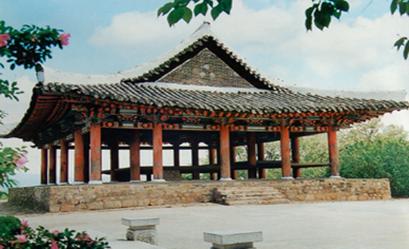
President
Chairman
"With his profound knowledge Comrade
There is a story of Thonggun Pavilion among many anecdotes telling about the personality of the President as a great man with both literary and military accomplishments.
The pavilion was built in the first half of the period of Koryo Kingdom and rebuilt in the period of the feudal Joson dynasty. It is situated in the township of Uiju County, North Phyongan Province.
It was used as a military command post of Uiju Fort, a major military base in the northwestern part of Korea during the Koryo Dynasty. As it is situated on the highest peak of Mt Samgak in the fort, it served as a military command post in times of emergency.
President
At the meeting he called on them to hold the first democratic election successfully and then climbed to the pavilion with the officials.
First built during the Koryo Kingdom, the pavilion shows the ingenious architecture of Korean ancestors and is located in a beautiful place and therefore it has been called one of eight scenic spots in the northwestern part of the country.
It was built as the northern command post of Uiju Fort. Located on the peak of Mt Samgak, the highest place of the fort in its north, the pavilion was designed to command battles, looking down at the Amnok River and the vicinity of it.
After feasting his eyes on the Amnok River flowing placidly at the foot of the peak and the surrounding scenery for a whole, he said that the pavilion commands a bird's eye view of the beautiful land of the country and that the country is picturesque everywhere.
He suddenly asked officials if they knew why it was called Thonggun Pavilion.
A local official answered that according to old people, it was called thus in the meaning that the Korean king who was deprived of Hansong during the Imjin Patriotic War in 1592, came to Uiju and wailed there. Then the President said it was not correct to say so and told the officials that it was a pavilion built to command troops at the time of foreign invasion.
He continued to say: Uiju, a geographically advantageous point of militarily importance, had played an important role in the battles against foreign invaders since the Koryo period. Our ancestors destroyed the invaders by commanding troops here. Thonggun Pavilion is a historical site renowned along with illustrious patriotic generals of our country.
Saying that Uiju was also named thus in the meaning that many righteous persons were produced there, he requested officials to rebuild the pavilion well to use the area as a pleasure ground for the people and a place for education in patriotism.
Like this, the President was not only a great thinker and theoretician and an outstanding leader but also a man of wide knowledge well versed in all domains including politics, the economy, military affairs and culture.
